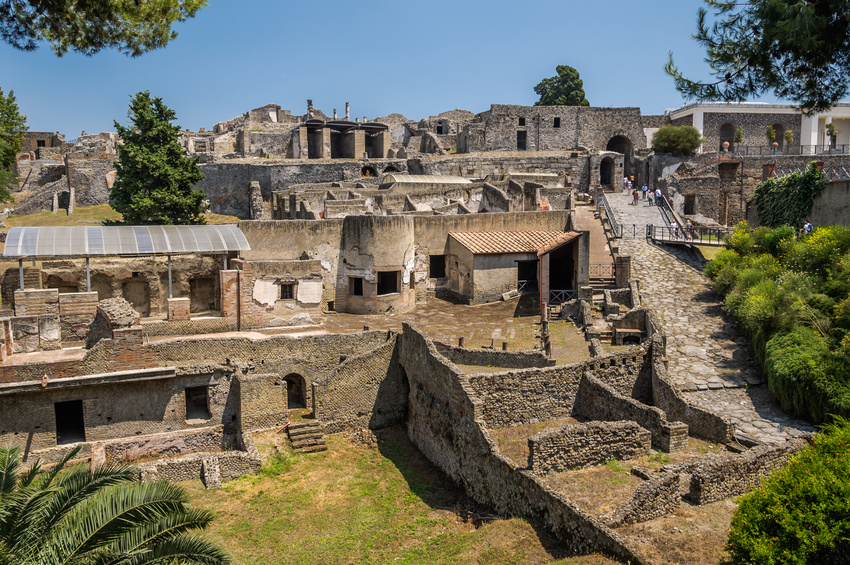
In 79 A.D. the Roman citizens of Pompeii and Ercolano were destroyed by the lava flow from Mount Vesuvius. It was only in 1738 that they were discovered and brought to the light, thanks to excavations funded by King Charles de Bourbon. A mass of red hot lapilli and a rain of ash covered people, houses and temples under a layer 4-5 meters thick, perfectly preserving until modern times a testament of Roman life from over 2000 years ago. In Pompeii you can admire the Amphitheater and Abbondanza Street, one of the most famous streets in the ancient Roman city. The ruins of houses and artisan stores are striking, bringing to mind the pace and customs of everyday life for the ancient Romans. A visit to the Garden of Fugitives shows the remainders of a group of farmers, caught in the middle of their work.
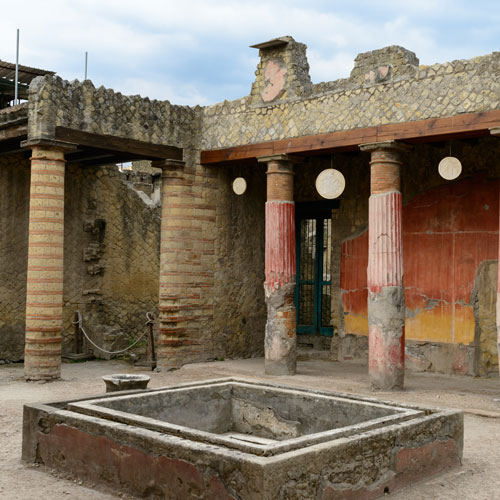
Unlike Pompeii, Ercolano was submerged by mud and ash that penetrated all the houses, transforming everything into one hard and compact layer. This allowed for an even better state of preservation of the ruins than those in Pompeii, especially for perishable materials such as wood and papyrus that were found partially intact within a luxurious villa and are still partially buried.1826 rolls of papyrus were found containing exclusively Greek texts. Ercolano contains many villas to explore as well as the surreal remains of a boat and its captain.
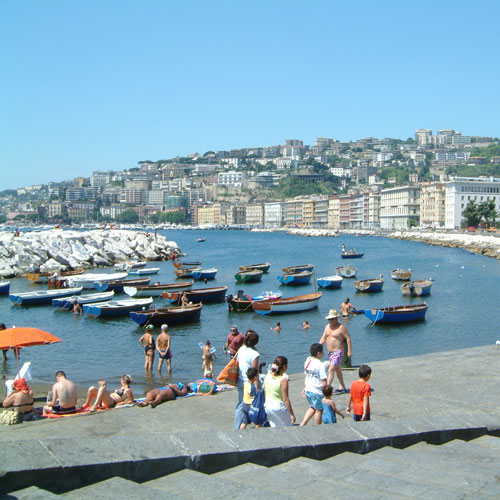
The fame of this city goes back centuries. From 600 B.C. to modern times, Cumans, Greeks, Romans, Goths and Byzantines, Normans and Angevins, Spanish, Austrians and French. Have all left their mark on the architecture, art, folklore, music, craftsmanship and cuisine of Naples. It is a city not to be missed! Its mix of attractions offers the possibility of a visit that embraces art, history, tradition and popular culture. The city is distinguished by an immense historic downtown, declared a World Heritage Site by UNESCO and rich in churches, monuments, palaces and picturesque alleys, including: Castel dell'Ovo, the spot where the Cumans landed, the Maschio Angiolino, the location of the palace of Charles I of Naples and the Royal Palace, the center of power in Naples overlooking the gorgeous Piazza Plebiscito. Nearby are the Teatro San Carlo, one of the most famous Italian theaters, and the famous Galleria Umberto. An important street to visit near the historic downtown is S. Gregorio Armeno, where you can admire the splendor of Neapolitan craftsmanship. For shopping lovers, the perfect spot is via Rome, the main street in Naples that was created as a pedestrian zone to offer tourists and locals a relaxing area for shopping. Finally, a must-see spot is the National Archeological Museum, which houses priceless archeological findings.
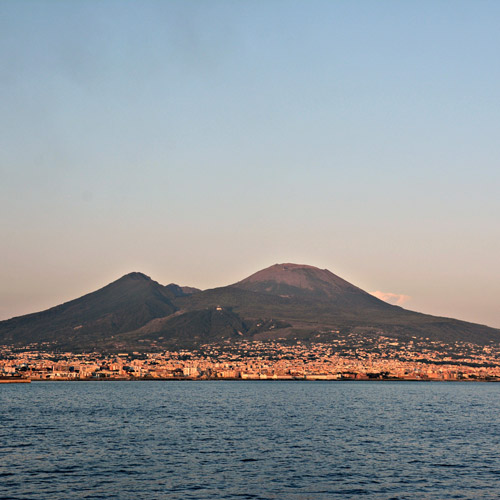
The mountain of fine wine and luxurious forests full of wild boar. This was Vesuvius for the inhabitants of Pompeii, Ercolano, Stabia, and Oplontis at least until that tragic day on August 24, 79 A.D. Vesuvius is still an active volcano today and its summit offers a breathtaking panorama from the gulf of Naples to the islands of Capri and Ischia. It is accessible by road (for 1000 meters), with the remaining 281 meters to the crater traveled by foot.
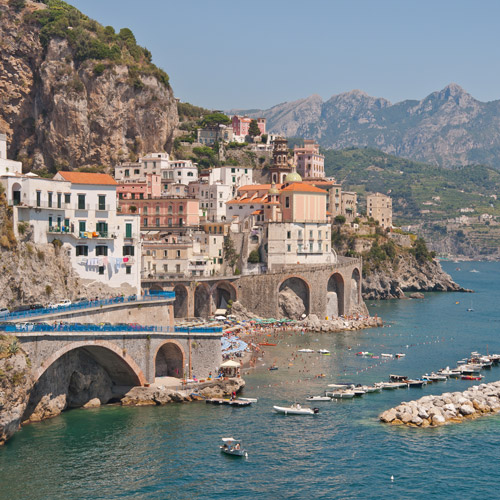
Some of the most striking spots on the coast, Positano, Amalfi and Ravello certainly deserve a special visit. Visiting all three of these towns in one day offers insight into their individual uniqueness. Positano is the perfect spot to envelop yourself in the remarkable history of its narrow alleys, rich in traditional, family-owned restaurants that have always distinguished the cuisine of Positano as one of the best on the Amalfi Coast. Here you can visit stores displaying the fashions of Positano and local handcrafted items including sandals, clogs and ceramics. The excursion continues with a visit to the sparkling Emerald Cave in Conca dei Marini. We then travel on to Amalfi, the first MARITIME REPUBLIC and birthplace of di Flavio Gioia, the inventor of the compass. In downtown Amalfi you can visit Saint Andrew's Cathedral whose distinguishing feature is a facade completely decorated with a mosaic from the 800s, the arsenal where the great galleys of the fleet were built and the paper museum, which still houses some of the most precious paper in the world We then travel on to Ravello, famous for its romantic panoramic views, encircled by a constellation of important monuments including: the Cathedral, Villa Cimbrone and Villa Rufolo. It was here in the gardens of the Villa Rufolo where in 1880 the great German musician Richard Wagner was inspired to compose his famous Parsifal. From here, we head to the Ravello Festival, one of the oldest Italian festivals that has distinguished Ravello as the "city of music".
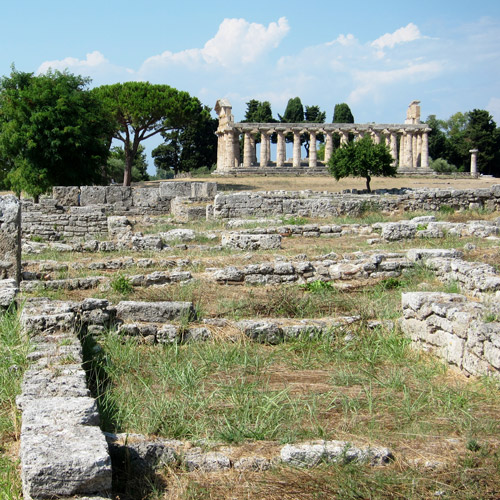
Paestum was founded in the 7th century by the Greeks under the ancient name of Poseidonia. This town is known above all for its large Doric temples that have made it one of the most famous archeological centers in Campania. Its three most interesting sites form the best architectural complex in Magna Grecia: the Temple of Athena, known in the past as the temple of Cerere, was composed of a pronaos with eight columns with ionic capitals, of which have remained only the bases and two capitals (the oldest in the Ionic style found in Italy). The Temple of Hera, also called the Basilica, was the largest that the Greeks built completely out of stone. Finally, the temple of Neptune, which according to some was actually dedicated to Hera, is considered a perfect example of the Doric temple architecture of Italy and Greece. All the findings of priceless historic and artistic value from Paestum are preserved in the National Archeological Museum, including the painted slabs of the so-called Tomb of the Diver, a unique example of painting from the Greek age in Magna Grecia.
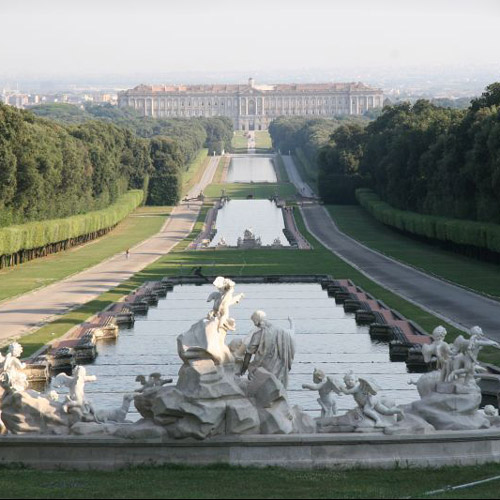
Caserta houses the famous palace of the same name, also known as the "Versailles di Naples", which was constructed by Bourbon in the 17th century. The Royal Palace of Caserta is one of the most beautiful and imposing palaces ever built in Italy. In addition to offering a marvelous example of neoclassical architecture, it also contains an enormous complex of parks with gardens where you can stroll and relax after visiting the palace. The Royal Palace of Caserta was built in1751 at the request of King Charles de Bourbon, who wanted a palace that could compare with residences in other European countries. The palace contains 1200 rooms and 1742 windows as well as a courtyard of unique and unsurpassed beauty. In the park, which spreads over a good 120 hectares, you can admire avenues rich with fountains, precious sculptures and finally the Great Cascade that adds a touch of magic to the palace.
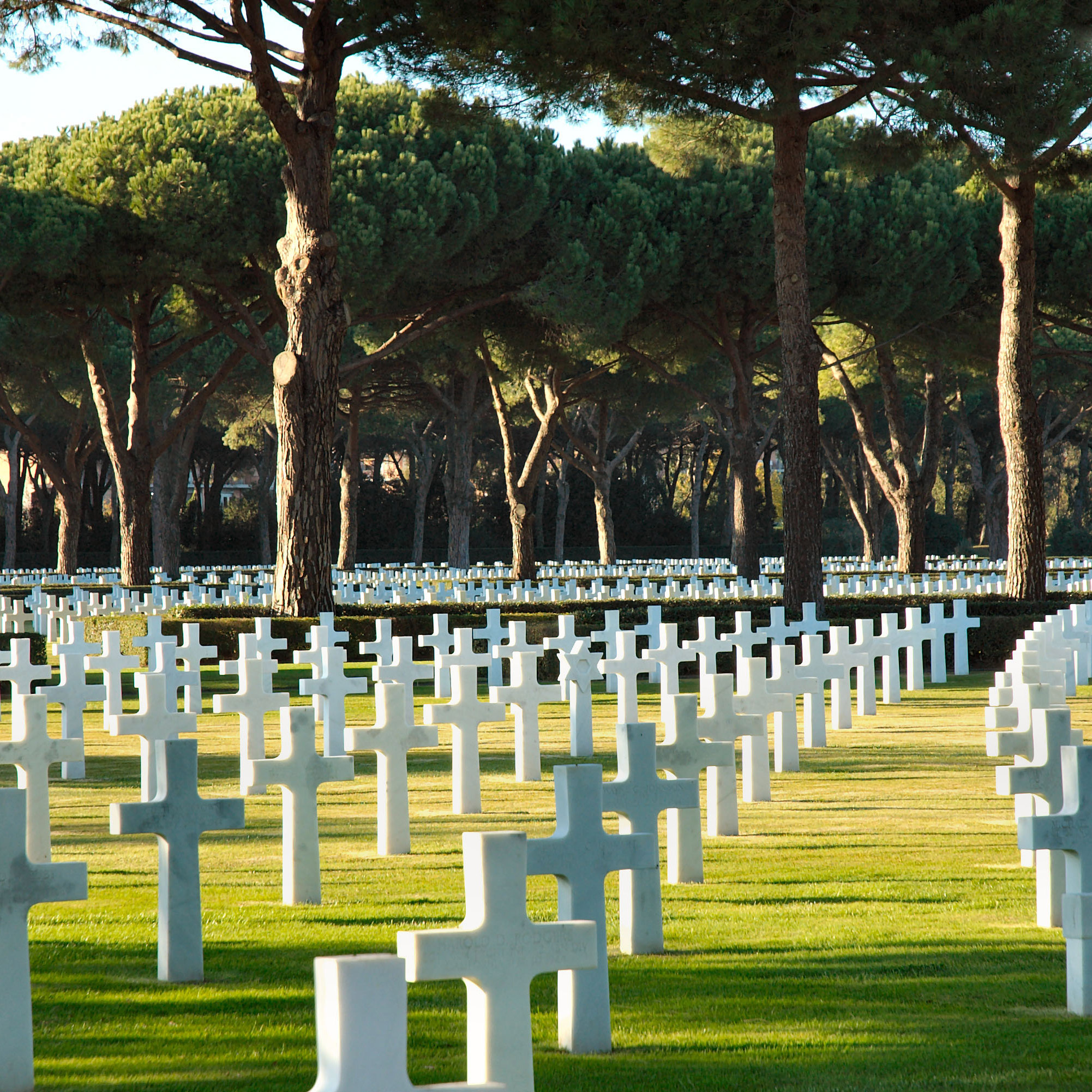
The American Cemetery and Memorial in Nettuno was created as a temporary war cemetery two days after the arrival of the allies, at 2 in the morning on January 22, 1944. In 1956 it became a permanent cemetery. Here, 7861 soldiers who fell during the campaigns in Sicily, the landing in Salerno and the bridgehead of Nettuno and Anzio were buried. These included seventeen women, including Red Cross workers, auxiliary military, and civilians. Beyond the monumental gate is an artificial lake and a vast field that holds the graves of the fallen, defined by large oaks and hedges of laurel. The graves, all of which are identical and fairly simple, are divided into ten sections. At the end of the field, rises an imposing mausoleum in travertine, the central peristyle of which holds a bronze monument dedicated to the "Brothers in Arms", the American soldiers and sailors. The peristyle is flanked on the left and right by a chapel and museum. The chapel walls are constructed in Carrara marble and engraved with the name, rank and unit of over three thousand missing soldiers. In the museum, on the west wall, three frescos illustrate the occupation of Sicily, the strategic air assaults and the Naples-Foggia campaign. The map on the east wall instead displays the landing at Anzio and Nettuno and the occupation of Rome.
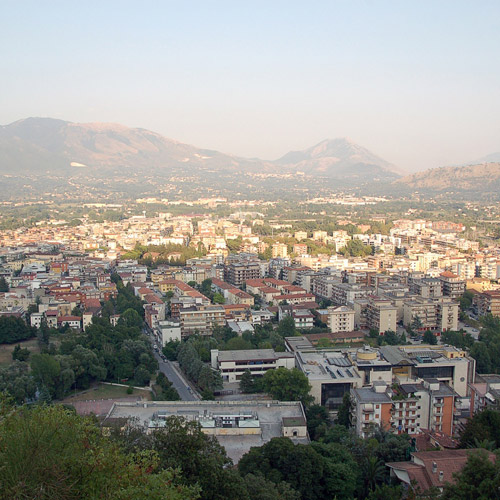
The city is located at the base of Montecassino while the Abbey sits on its summit. The Montecassino monastery, founded by Saint Benedict around 529, rises from the base of a preexisting Roman fort in the town of Casinum and was made famous by the prodigious life and sepulcher of its founder. Over the centuries, Montecassino has experienced a lengthy history of holiness, culture and art that has made it famous all over the world. The Abbey has been destroyed three times over the course of history. In 577 it was destroyed by the Lombards lead by Zontone, Duke of Beneveneto and then rebuilt in the 8th century by Petronax of Brescia on a mandate from Pope Gregory II. In 883 it was sacked and burnt by the Saracens, causing the deaths of many monks and the Benedictine abbot Bertharius, founder of medieval Cassino. The surviving monks fled to Teano and then Capua, and it was only towards the mid 10th century that they returned to Montecassino. In the 11th century, thanks to the Abbot Desiderius and Pope Gregory VII, the monastery was rebuilt and embellished with mosaics, enamels, and liturgical gold from the East. In 1349 the monastery was destroyed for the third time by an earthquake, and once again rebuilt with various additions and embellishments, giving it a grand monumental appearance until 15-02-1944 when it was again destroyed during the Second World War. It was rebuilt under Abbott Rea "where it was, as it was". After its many hardships, Montecassino has become like an Oak tree: though broken by the wind, it is always reborn with its strength intact.
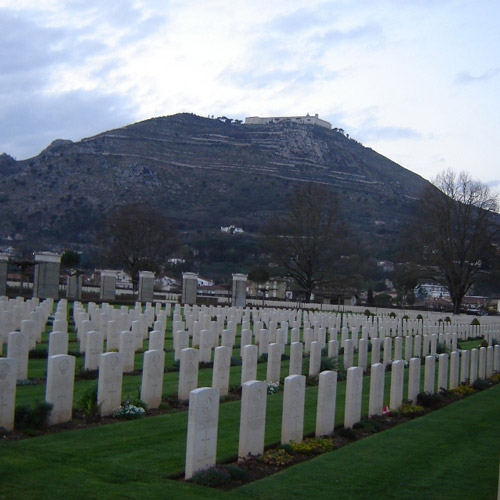
In memory of the sacrifices of the battle of Cassino (1943-1944), the nations that took part in the fighting wanted the thousands that fell along the Gustav line to be buried where they had fought. Cassino and its surrounding countryside thus houses numerous military memorials: German Cemetery Colle Marino, a hamlet of Caira, is one of the most important German cemeteries in Italy and holds 20,027 soldiers who fell in combat in southern Italy. It was begun in 1959 by the architect Tischler and completed by professor Offenberg. Commonwealth Cemetery Located along the road that leads to S. Angelo in Theodice, it holds 4265 bodies; it was inaugurated in 1956 in the presence of General Alexander and all the ambassadors of the Commonwealth. Polish Cemetery Montecassino, 1,052 bodies from the 2nd Polish Corps, including Gen. Annders and the Archbishop chaplain Gawlina, who died in 1970 and were transported here on request. The memorial is entrusted to the care of the monks of Montecassino. French Cemetery Venafro originally held 4,600 bodies of the French Expeditionary Corps, and now has only 3414 as many were returned home after the war.